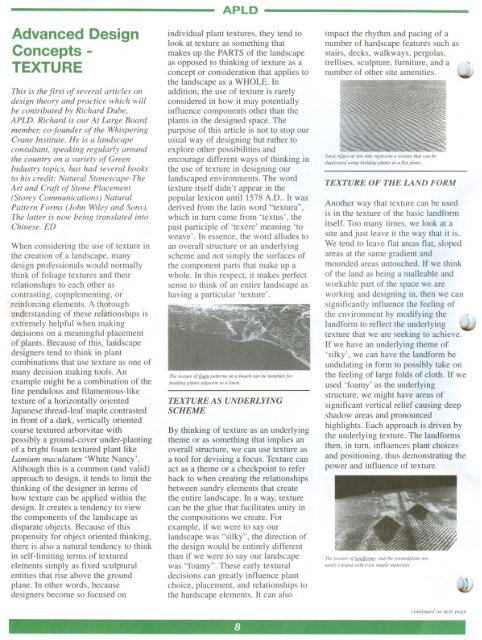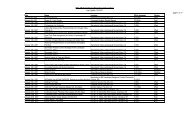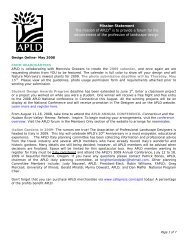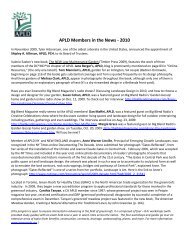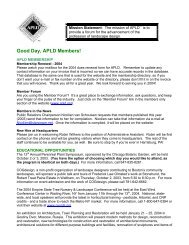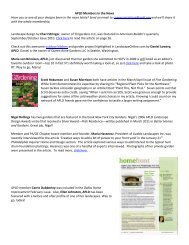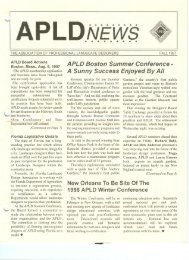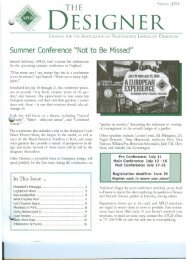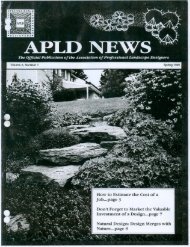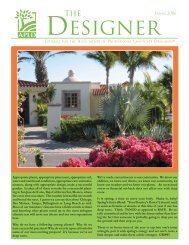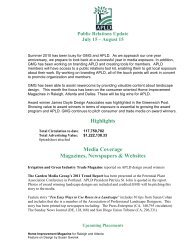Confer~nce 1999 - Association of Professional Landscape Designers
Confer~nce 1999 - Association of Professional Landscape Designers
Confer~nce 1999 - Association of Professional Landscape Designers
Create successful ePaper yourself
Turn your PDF publications into a flip-book with our unique Google optimized e-Paper software.
APLD<br />
Advanced Design<br />
Concepts<br />
TEXTURE<br />
This is the first <strong>of</strong> several articles on<br />
design theory and practice which will<br />
be contributed by Richard Dube,<br />
APLD. Richard is our At Large Board<br />
member, co-founder <strong>of</strong> the Whispering<br />
Crane Institute. He is a landscape<br />
consultant, speaking regularly around<br />
the country on a variety <strong>of</strong> Green<br />
Industry topics, has had several books<br />
to his credit: Natural Stonescape- The<br />
Art and Craft <strong>of</strong> Stone Placement<br />
(Storey Communications) Natural<br />
Pattern Forms (John Wiley and Sons).<br />
The latter is now being translated into<br />
Chinese. ED<br />
When considering the use <strong>of</strong> texture in<br />
the creation <strong>of</strong> a landscape, many<br />
design pr<strong>of</strong>essionals would normally<br />
think <strong>of</strong> foliage textures and their<br />
relationships to each other as<br />
contrasting, c0!TIplementing, or<br />
reinforcing elements. A thorough<br />
understanding <strong>of</strong> these relationships is<br />
extremely helpful when making<br />
decisions on a meaningful placement<br />
<strong>of</strong> plants. Because <strong>of</strong> this, landscape<br />
designers tend to think in plant<br />
combinations that use texture as one <strong>of</strong><br />
many decision making tools. An<br />
example might be a combination <strong>of</strong> the<br />
fine pendulous and filamentous-like<br />
texture <strong>of</strong> a horizontally oriented<br />
Japanese thread-leaf maple contrasted<br />
in front <strong>of</strong> a dark, vertically oriented<br />
coarse textured arborvitae with<br />
possibly a ground-cover under-planting<br />
<strong>of</strong> a bright foam textured plant like<br />
Lamium maculatum 'White Nancy'.<br />
Although this is a common (and valid)<br />
approach to design, it tends to limit the<br />
thinking <strong>of</strong> the designer in terms <strong>of</strong><br />
how texture can be applied within the<br />
design. It creates a tendency to view<br />
the components <strong>of</strong> the landscape as<br />
disparate objects. Because <strong>of</strong> this<br />
propensity for object oriented thinking,<br />
there is also a natural tendency to think<br />
in self-limiting terms <strong>of</strong> textured<br />
elements simply as fixed sculptural<br />
entities that rise above the ground<br />
plane. In other words, because<br />
designers become so focused on<br />
individual plant textures, they tend to<br />
look at texture as something that<br />
makes up the PARTS <strong>of</strong> the landscape<br />
as opposed to thinking <strong>of</strong> texture as a<br />
concept or consideration that applies to<br />
the landscape as a WHOLE. In<br />
addition, the use <strong>of</strong> texture is rarely<br />
considered in how it may potentially<br />
influence components other than the<br />
plants in the designed space. The<br />
purpose <strong>of</strong> this article is not to stop our<br />
usual way <strong>of</strong> designing but rather to<br />
explore other possibilities and<br />
encourage different ways <strong>of</strong> thinking in<br />
the use <strong>of</strong> texture in designing our<br />
landscaped environments. The word<br />
texture itself didn't appear in the<br />
popular lexicon until 1578 A.D .. It was<br />
derived from the latin word "textura",<br />
which in turn came from 'textus', the<br />
past participle <strong>of</strong> 'texere' meaning 'to<br />
weave'. In essence, the word alludes to<br />
an overall structure or an underlying<br />
scheme and not simply the surfaces <strong>of</strong><br />
the component parts that make up a<br />
whole. In this respect, it makes perfect<br />
sense to think <strong>of</strong> an entire landscape as<br />
having a particular 'texture'.<br />
The texture <strong>of</strong>.f!Hm! patterns 011 a beach can be temp/ate for<br />
bedding plants adjacent to a lawn.<br />
TEXTURE<br />
SCHEME<br />
AS UNDERLYING<br />
By thinking <strong>of</strong> texture as an underlying<br />
theme or as something that implies an<br />
overall structure, we can use texture as<br />
a tool for devising a focus. Texture can<br />
act as a theme or a checkpoint to refer<br />
back to when creating the relationships<br />
between sundry elements that create<br />
the entire landscape. In a way, texture<br />
can be the glue that facilitates unity in<br />
the compositions we create. For<br />
example, if we were to say our<br />
landscape was "silky", the direction <strong>of</strong><br />
the design would be entirely different<br />
than if we were to say our landscape<br />
was "foamy". These early textural<br />
decisions can greatly influence plant<br />
choice, placement, and relationships to<br />
the hardscape elements. It can also<br />
impact the rhythm and pacing <strong>of</strong> a<br />
number <strong>of</strong> hardscape features such as<br />
stairs, decks, walkways, pergolas,<br />
trellises, sculpture, furniture, and a ,<br />
number <strong>of</strong> other site amenities.<br />
Sand ridges at low tide represent a texture Ihm can be<br />
duplicated using bedding plants in a flat plane.<br />
TEXTURE<br />
OF THE LAND FORM<br />
Another way that texture can be used<br />
is in the texture <strong>of</strong> the basic landform<br />
itself. Too many times, we look at a<br />
site and just leave it the way that it is.<br />
We tend to leave flat areas flat, sloped<br />
areas at the same gradient and<br />
mounded areas untouched. If we think<br />
<strong>of</strong> the land as being a malleable and<br />
workable part <strong>of</strong> the space we are<br />
working and designing in, then we can<br />
significantly influence the feeling <strong>of</strong><br />
the environment by modifying the<br />
landform to reflect the underlying<br />
texture that we are seeking to achieve.<br />
If we have an underlying theme <strong>of</strong><br />
'silky', we can have the landform be<br />
undulating in form to possibly take on<br />
the feeling <strong>of</strong> large folds <strong>of</strong> cloth. If we<br />
used 'foamy' as the underlying<br />
structure, we might have areas <strong>of</strong><br />
significant vertical relief causing deep<br />
shadow areas and pronounced<br />
highlights. Each approach is driven by<br />
the underlying texture. The landforms<br />
then, in turn, influences plant choices<br />
and positioning, thus demonstrating the<br />
power and influence <strong>of</strong> texture.<br />
The texture <strong>of</strong> londfonns Gild the groundplane are<br />
easily created ",jth el'en simple materials.<br />
continued<br />
on next page


